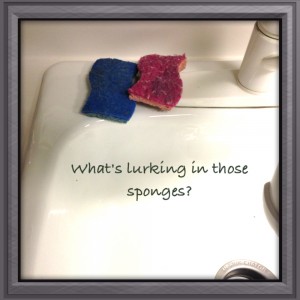I am totally behind going “green” and making changes in my own house and at work to be more Eco-friendly. I really do believe that it is important to live a lifestyle without wasting natural resources frivolously; it isn’t a way to show that you have money, to be wasteful with natural resources is just pointless, and truly lazy. There are tons of products on the market that have cleaning agents with less abrasive or fewer harsh chemical agents in them to clean your home, and in an effort to be green, people are using sponges and dish rags/towels in lieu of paper towels, or the equivalent, to clean up a pretty nasty mess, and opting to clean and reuse those sponges or towels. It’s great for the environment, but are we putting ourselves at risk for hidden viruses and bacteria in those reusable materials?
When cooking with meat and eggs, there are a risk for E. coli and salmonella that can hide out in crevices of wooden cutting boards, in the little holes in your sponges, and in the fabric of dish towels. Between lots of moisture and food sources, it really makes for a perfect breeding spot for viruses and bacteria: dark, moisture filled places with bits of food for the bacteria to feed off of, is their own little heaven! With ideal breeding spaces, these bacterial can grow into the millions in 24 hours time, and the more bacteria present, the bigger the risk that you will get infected by them. Just think that every time you swipe your sponge over your counter, you are leaving a trail of bacteria that you can’t see. Yikes!
How do I prevent that?
Old school bleach, which I know is horrible ecologically speaking, is really fantastic at killing off those nasty bacteria, quickly and effectively! And many studies have shown that the “greener”the product, the less effective it is at killing off E. coli and salmonella. But there are some tricks you can use to help rid your kitchen of these nasty bugs:
– Use white vinegar (which smells horrid) on your counter tops and then follow with hot, soapy water to cut the smell and help wash away the bacteria. (bacteria are fickle and need the perfect temperature to grow, they don’t like places that are hot, so hot water can help to kill them off!)
– Make sure that your sponges are clean by changing them out weekly.
– You can extend the life of sponges by getting them moist and zapping them in the microwave for 2 minutes a day to kill off most creepy things living in there.
– Wash dish rags and towels frequently in hot water cycles, especially if they are used to clean up raw meat/egg spills (or wiping your hands after touching such items).
– You can also always add vinegar to the wash to help kill off bacteria
– If you use a dishwasher with some frequency, toss your sponge into the dishwasher every time you run it, and it will come out fresh and clean and bacteria free!
So, white vinegar can do a pretty good job on killing off that bacteria, and following it with the hot soapy water (using a sponge free of bacteria) can help to decrease your risk of infection and cut down on spreading those nasty little bacteria all over your clean kitchen surfaces. Bleach really is the best way to kill off the bacteria because you spray some from a bottle, a quick swipe of your sponge/rag and the bacteria are eradicated, but for those that are intensely eco-friendly, white vinegar, hot soapy water, bacteria-free cleaning tools, and elbow grease are your friends! Next time you grab your green cleaning product, read the label to see what the active ingredient is, you may be wasting your money, as white vinegar is under a dollar for a liter!
Yours in Good Health
B

